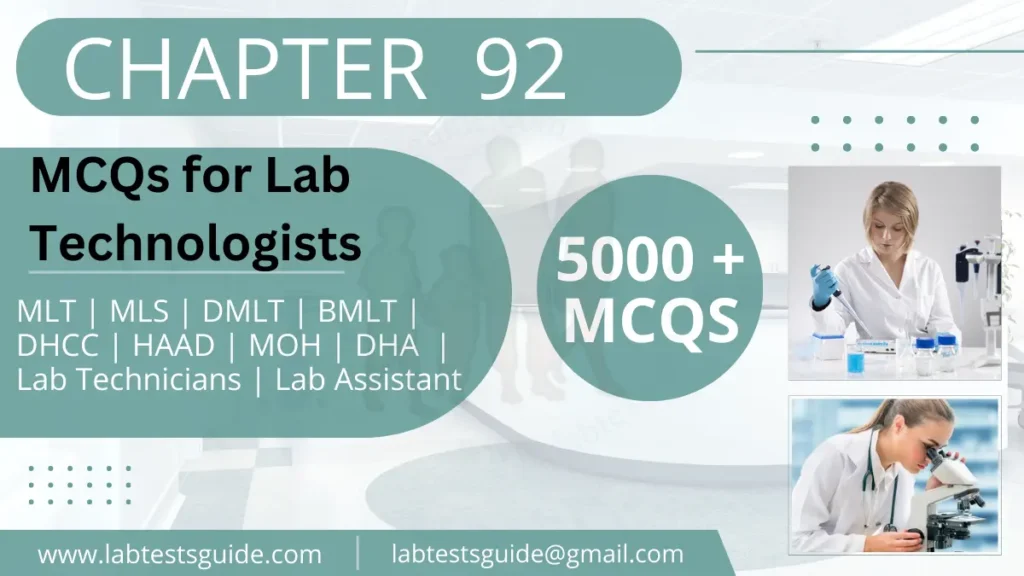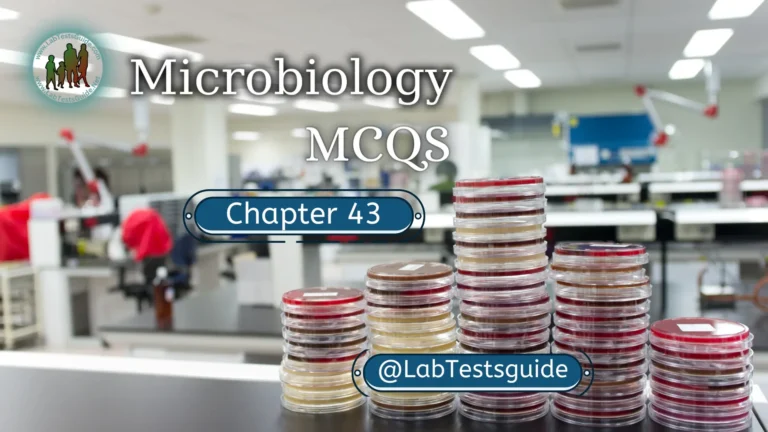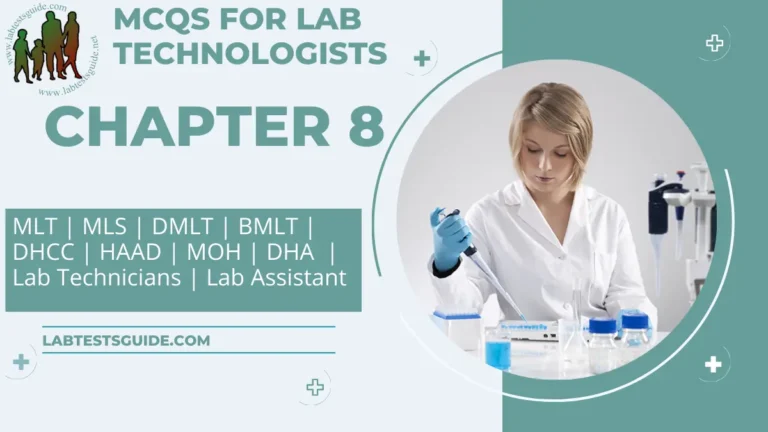4551 to 4600 MCQs for Lab Technician and Technologist Exam Preparation
5000 Plus MCQs for Lab Technician and Technologists are designed to test the knowledge and proficiency of laboratory professionals who work in the field of clinical laboratory science. These questions cover a wide range of topics related to laboratory science, including anatomy, physiology, microbiology, chemistry, and hematology.

If You like then share this to your friends and other social media.
If You have any question and suggestions then please Contact us Here
Questions 4551 to 4600
- A drug which prevents uric acid synthesis by inhibiting the enzyme xanthine oxidase is
- Aspirin
- Allopurinol ✔
- Colchicine
- Probenecid
- Which of the following is required for crystallization and storage of the hormone insulin?
- Mn++
- Mg++
- Ca++
- Zn++✔
- Oxidation of which substance in the body yields the most calories
- Glucose
- Glycogen
- Protein
- Lipids✔
- Milk is deficient in which vitamins?
- Vitamin C✔
- Vitamin A
- Vitamin B2
- Vitamin K
- Milk is deficient of which mineral?
- Phosphorus
- Sodium
- Iron✔
- Potassium
- Synthesis of prostaglandinsis is inhibited by?
- Aspirin✔
- Arsenic
- Fluoride
- Cyanide
- HDL is synthesized and secreted from
- Pancreas
- Liver✔
- Kidney
- Muscle
- Which are the cholesterol esters that enter cells through the receptor-mediated endocytosis of lipoproteins hydrolyzed?
- Endoplasmin reticulum
- Lysosomes✔
- Plasma membrane receptor
- Mitochondria
- Which of the following phospholipids is localized to a greater extent in the outer leaflet of the membrane lipid bilayer?
- Choline phosphoglycerides✔
- Ethanolamine phosphoglycerides
- Inositol phosphoglycerides
- Serine phosphoglycerides
- All the following processes occur rapidly in the membrane lipid bilayer except
- Flexing of fatty acyl chains
- Lateral diffusion of phospholipids
- Transbilayer diffusion of phopholipids✔
- Rotation of phospholipids around their long axes
- Which of the following statement is correct about membrane cholesterol?
- The hydroxyl group is located near the centre of the lipid layer
- Most of the cholesterol is in the form of a cholesterol ester
- The steroid nucleus form forms a rigid, planar structure✔
- The hydrocarbon chain of cholesterol projects into the extracellular fluid
- Which one is the heaviest particulatebcomponent of the cell?
- Nucleus✔
- Mitochondria
- Cytoplasm
- Golgi apparatus
- Which one is the largest particulate of thecytoplasm?
- Lysosomes
- Mitochondria✔
- Golgi apparatus
- Entoplasmic reticulum
- The degradative Processess are categorized under the heading of
- Anabolism
- Catabolism✔
- Metabolism
- None of the above
- The exchange of material takes place
- Only by diffusion
- Only by active transport
- Only by pinocytosis
- All of these ✔
- The average pH of Urine is
- 7.0
- 6.0 ✔
- 8.0
- 0.0
- The pH of blood is 7.4 when the ratio between H2CO3 and NaHCO3 is
- 1 : 10
- 1 : 20 ✔
- 1 : 25
- 1 : 30
- The phenomenon of osmosis is opposite to that of
- Diffusion✔
- Effusion
- Affusion
- Coagulation
- The surface tension in intestinal lumen between fat droplets and aqueous medium is decreased by
- Bile Salts✔
- Bile acids
- Conc. H2SO4
- Acetic acid
- Which of the following is located in the mitochondria?
- Cytochrome oxidase
- Succinate dehydrogenase
- Dihydrolipoyl dehydrogenase
- All of these✔
- The most active site of protein synthesis is the
- Nucleus
- Ribosome✔
- Mitochondrion
- Cell sap
- The fatty acids can be transported into and out of mitochondria through
- Active transport
- Facilitated transfer✔
- Non-facilitated transfer
- None of these
- Mitochondrial DNA is
- Circular double stranded✔
- Circular single stranded
- Linear double helix
- None of these
- The absorption of intact protein from the gut in the foetal and newborn animals takes place by
- Pinocytosis
- Passive diffusion
- Simple diffusion
- Active transport
- The cellular organelles called “suicide bags” are
- Lysosomes✔
- Ribosomes
- Nucleolus
- Golgi’s bodies
- From the biological viewpoint, solutions can be grouped into
- Isotonic solution
- Hypotonic solutions
- Hypertonic solution
- All of these✔
- Bulk transport across cell membrane is accomplished by
- Phagocytosis
- Pinocytosis
- Extrusion
- All of these✔
- The ability of the cell membrane to act as a selective barrier depends upon
- The lipid composition of the membrane
- The pores which allows small molecules
- The special mediated transport systems
- All of these✔
- Carrier protein can
- Transport only one substance
- Transport more than one substance
- Exchange one substance to another
- Perform all of these functions✔
- A lipid bilayer is permeable to
- Urea✔
- Fructose
- Glucose
- Potassium
- The Golgi complex
- Synthesizes proteins
- Produces ATP
- Provides a pathway for transporting chemicals
- Forms glycoproteins✔
- The following points about microfilaments are true except
- They form cytoskeleton with microtubules
- They provide support and shape
- They form intracellular conducting channels✔
- They are involved in muscle cell contraction
- The follow ing substances are cell inclusions except
- Melanin
- Glycogen
- Lipids
- Centrosome✔
- Fatty acids can be transported into and out of cell membrane by
- Active transport
- Facilitated transport✔
- Diffusion
- Osmosis
- Enzymes catalyzing electron transport are present mainly in the
- Ribosomes
- Endoplasmic reticulum
- Lysosomes
- Inner mitochondrial membrane✔
- Mature erythrocytes do not contain
- Glycolytic enzymes
- HMP shunt enzymes
- Pyridine nucleotide✔
- ATP
- In mammalian cells rRNA is produced mainly in the
- Endoplasmic reticulum
- Ribosome
- Nucleolus✔
- Nucleus
- Genetic information of nuclear DNA is transmitted to the site of protein synthesis by
- rRNA
- mRNA✔
- tRNA
- Polysomes
- The power house of the cell is
- Nucleus
- Cell membrane
- Mitochondria✔
- Lysosomes
- The d igest ive enzymes of ce l lu lar compounds are confined to
- Lysosomes✔
- Ribosomes
- Peroxisomes
- Polysomes
- The general formula of monosaccharides is
- CnH2nOn✔
- C2nH2On
- CnH2O2n
- CnH2nO2n
- The general formula of polysaccharides is
- (C6H10O5)n✔
- (C6H12O5)n
- (C6H10O6)n
- (C6H10O6)n
- The aldose sugar is
- Glycerose ✔
- Ribulose
- Erythrulose
- Dihydoxyacetone
- A triose sugar is
- Glycerose✔
- Ribose
- Erythrose
- Fructose
- A pentose sugar is
- Dihydroxyacetone
- Ribulose✔
- Erythrose
- Glucose
- The pentose sugar present mainly in the heart muscle is
- Lyxose
- Ribose✔
- Arabinose
- Xylose
- Polysaccharides are
- Polymers✔
- Acids
- Proteins
- Oils
- The number of isomers of glucose is
- 2
- 4
- 8
- 16✔
- Two sugars which differ from one another only in configuration around a single carbon atom are termed
- Epimers✔
- Anomers
- Optical isomers
- Stereoisomers
- Isomers differing as a result of variations in configuration of the —OH and —H on carbon atoms 2, 3 and 4 of glucose are known as
- Epimers✔
- Anomers
- Optical isomers
- Steroisomers
The questions are typically designed to assess the technical skills and knowledge required for the laboratory profession, including the ability to analyze laboratory test results, perform laboratory procedures, and maintain laboratory equipment.
To prepare for these MCQs, candidates should have a thorough understanding of the key concepts and principles of laboratory science. They should also be familiar with common laboratory equipment and procedures, as well as laboratory safety protocols.
Candidates may also benefit from studying specific laboratory science textbooks or taking online courses that cover the material tested in the MCQs. Additionally, practicing sample MCQs and reviewing the answers can help candidates identify areas where they may need to improve their knowledge or skills.
Overall, the MCQs for lab technologists are designed to be challenging and comprehensive, requiring candidates to demonstrate a high level of proficiency in the field of laboratory science.
Possible References Used







